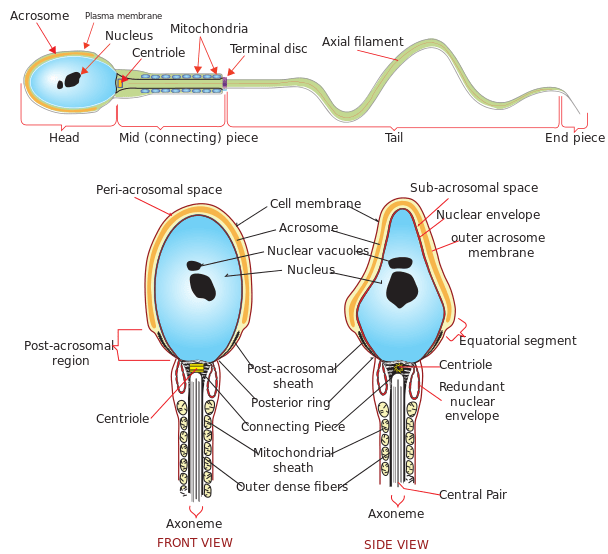Difference Between Spermiogenesis and Spermiation
Table of Contents
Key Difference – Spermiogenesis vs Spermiation
Spermatogenesis is a process through which mature sperms are produced from the germ cells in males. The germ cells are present in the seminiferous tubules of the testis. The process starts from the mitotic division of stem cells that are present closer to the basement membrane. These stem cells are referred to as spermatogonial stem cells. The whole process takes place under different stages with varied cell divisions. Spermiogenesis and spermiation are such subdivisions of spermatogenesis. Spermiogenesis is a process by which spermatids are transformed into mature spermatozoa whilst spermiation is the process where the spermatozoa are released from the Sertoli cells into the cavity of seminiferous tubules. This is the key difference between Spermiogenesis and Spermiation.
CONTENTS
1. Overview and Key Difference
2. What is Spermiogenesis
3. What is Spermiation
4. Similarities Between Spermiogenesis and Spermiation
5. Side by Side Comparison – Spermiogenesis vs Spermiation in Tabular Form
6. Summary
What is Spermiogenesis?
Spermiogenesis is defined as the final process of spermatogenesis where spermatids are transformed into mature spermatozoa. During this process, the maturation of spermatids takes place. With respect to the morphology of the spermatid, it is a circular shaped cell that possesses essential cellular organelles such as the nucleus, mitochondria, Golgi apparatus and centriole for cell division. Each and every organelle present in the spermatid involves the maturation process. In the context of a typical spermiogenesis process, it is composed of four major stages including Golgi phase, cap phase, tail formation phase and maturation phase.
In the Golgi phase, spermatids initiate the development of polarity. Until the Golgi phase, the spermatids are present as radially symmetrical cells. With the initiation of this phase, the head regions of the sperms are formed. The Golgi complex synthesizes the necessary enzymes for the formation of the acrosome that is present in the tip of the sperm head. The acrosome contains digestive enzymes that are used to penetrate the female ovum. At the other end, the neck region of the sperm will be developed, and it will be filled with many numbers of mitochondria. During this phase, condensation of spermatid DNA also takes place.

Figure 01: Sperm
During the cap phase, Golgi apparatus surrounds the condensed DNA in the nucleus and forms the acrosomal cap. Out of the two centrioles present in the mid-region of the spermatid, one centriole initiates elongation and results in the formation of the tail of the sperm. This is the tail formation phase. During the final stage, which is the maturation phase, the excess cytoplasm of the spermatid will be phagocytosed. This is done by the surrounding Sertoli cells that are present in the testis.
What is Spermiation?
Spermiation is a process through which mature spermatids resulted from spermiogenesis are released from the Sertoli cells of the testis. These mature spermatids are released into the lumen of the seminiferous tubules. This is an important process where it determines the number of sperms that enter to the epididymis and also the ejaculating sperm content. Spermiation is a complex process. Under healthy conditions, this process takes for several days. During Spermiation, the mature spermatids are initially arranged along the luminal edge of the seminiferous tubules. The process is completed when the spermatids are released into the tubule lumen. The resulted mature spermatid lacks motility. These non-motile sperms are transported to the epididymis along with the testicular fluid that is secreted by the Sertoli cells.
The movement is facilitated by the peristaltic contraction. In the epididymis, the mature spermatid gains motility.The extra cytoplasm of the spermatids that are known residual body is digested by phagocytosis directed by the Sertoli cells itself. Even though the primary function of the spermiogenesis process is the release of mature spermatids, extensive remodelling of the spermatid takes place resulting in a streamlined spermatozoan. This process is now considered as a potential target in the context of male contraceptives since it could prevent the release the sperms in to the lumen of the seminiferous tubule and then to the epididymis.
What are the Similarities Between Spermiogenesis and Spermiation?
- Both Spermiogenesis and Spermiation involve in the production of sperms.
- Both Spermiogenesis and Spermiation processes are two important parts of the spermatogenesis.
What is the Difference Between Spermiogenesis and Spermiation?
Spermiogenesis vs Spermiation | |
| Spermiogenesis is the process through which spermatids are transformed into mature spermatozoa. | Spermiation is the process where the spermatozoa are released from the Sertoli cells into the cavity of seminiferous tubules. |
Summary – Spermiogenesis vs Spermiation
Spermiogenesis is defined as the final process of spermatogenesis where spermatids are transformed into mature spermatozoa. During this process, the maturation of spermatids takes place. In the context of a typical spermiogenesis process, it is composed of four major stages including Golgi phase, cap phase, tail formation phase and maturation phase. In the context of spermiation, it is a process by where mature spermatids resulted from spermiogenesis are released from the Sertoli cells of the testis. Even though the primary function of the spermiogenesis process is the release of mature spermatids, extensive remodelling of the spermatid takes place that results in a streamlined spermatozoan.
Reference:
1.“3.3 Spermatogenesis.” Spermatogenesis, www.embryology.ch/anglais/cgametogen/spermato03.html.
Odonnell, Liza, et al. “Spermiation.” Spermatogenesis, vol. 1, no. 1, 2011, pp. 14–35., doi:10.4161/spmg.1.1.14525.
2.“Spermatogenesis and Spermiation – Anatomy & Physiology.” Spermatogenesis and Spermiation – Anatomy & Physiology – WikiVet English, Available here
Image Courtesy:
1.’Complete diagram of a human spermatozoa en’By Mariana Ruiz Villarreal spermatozoa- Own work (Public Domain) via Commons Wikimedia
ncG1vNJzZmivp6x7pbXFn5yrnZ6YsqOx07CcnqZemLyue8OinZ%2Bdopq7pLGMm5ytr5Wau26%2Fz56ppqGfnLKvsdKiqmaZnpl6t7%2BMrKeeqp2errW1zqdm